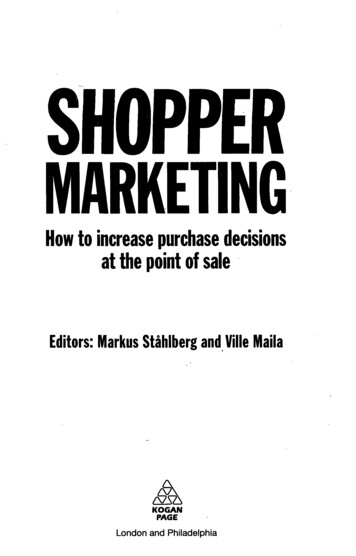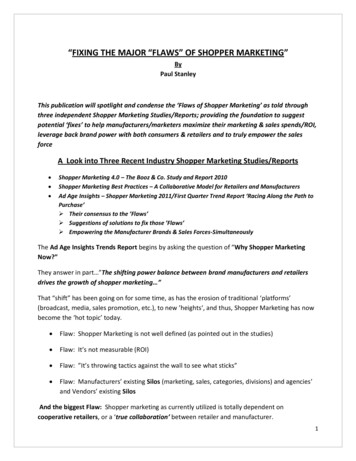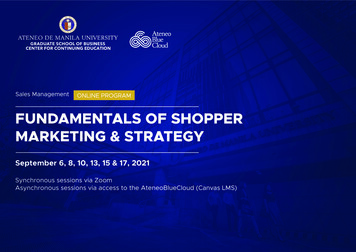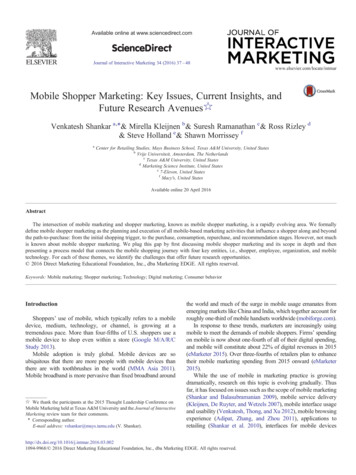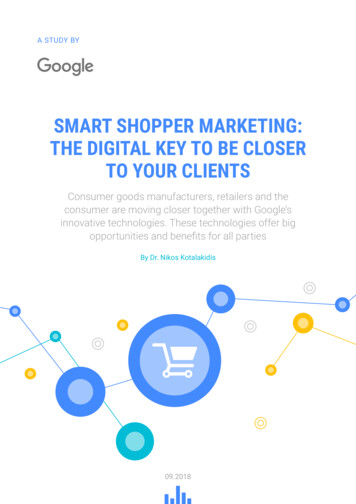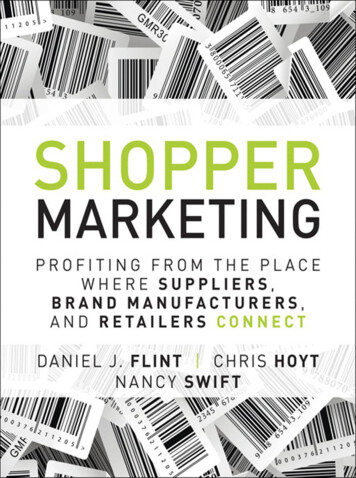
Transcription
Shopper Marketing
This page intentionally left blank
Shopper MarketingProfiting from the Place Where Suppliers, BrandManufacturers, and Retailers ConnectDaniel J. FlintChris HoytNancy Swift
Associate Publisher: Amy NeidlingerExecutive Editor: Jeanne Glasser LevineOperations Specialist: Jodi KemperCover Designer: Chuti PrasertsithManaging Editor: Kristy HartProject Editor: Elaine WileyCopy Editor: Geneil BreezeProofreader: Debbie WilliamsIndexer: Lisa StumpfSenior Compositor: Gloria SchurickManufacturing Buyer: Dan Uhrig 2014 by Daniel J. Flint, Chris Hoyt, and Nancy SwiftUpper Saddle River, New Jersey 07458For information about buying this title in bulk quantities, or for special sales opportunities(which may include electronic versions; custom cover designs; and content particular to your business,training goals, marketing focus, or branding interests), please contact our corporate sales department atcorpsales@pearsoned.com or (800) 382-3419.For government sales inquiries, please contact governmentsales@pearsoned.com.For questions about sales outside the U.S., please contact international@pearsoned.com.Company and product names mentioned herein are the trademarks or registered trademarks of theirrespective owners.All rights reserved. No part of this book may be reproduced, in any form or by any means, withoutpermission in writing from the publisher.Printed in the United States of AmericaFirst Printing June 2014ISBN-10: 0-13-348142-5ISBN-13: 978-0-13-348142-6Pearson Education LTD.Pearson Education Australia PTY, Limited.Pearson Education Singapore, Pte. Ltd.Pearson Education Asia, Ltd.Pearson Education Canada, Ltd.Pearson Educación de Mexico, S.A. de C.V.Pearson Education—JapanPearson Education Malaysia, Pte. Ltd.Library of Congress Control Number: 2014933848
This book is dedicated to all the shopper marketing professionals working diligentlyfor long hours to improve the shopping experience and to all the scholars passionateabout research that can assist the shopper marketing discipline.
This page intentionally left blank
ContentsIntroduction What Is This Book All About? . . . . . . . . . . . . . . . . . . . . . . . . . . . . . . . .xviiChapter 1Shopper Marketing Overview . . . . . . . . . . . . . . . . . . . . . . . . . . . . . . . . . . .1A Brief History . . . . . . . . . . . . . . . . . . . . . . . . . . . . . . . . . . . . . . . . . . . . . . . . . . .3Shopper Marketing Defined . . . . . . . . . . . . . . . . . . . . . . . . . . . . . . . . . . . . . . . . .5Let’s See It! . . . . . . . . . . . . . . . . . . . . . . . . . . . . . . . . . . . . . . . . . . . . . . . . . . . . . .9Eight Principles of Shopper Marketing . . . . . . . . . . . . . . . . . . . . . . . . . . . . . . . .9A Process of Doing Shopper Marketing . . . . . . . . . . . . . . . . . . . . . . . . . . . . . .16Interesting Findings from Research . . . . . . . . . . . . . . . . . . . . . . . . . . . . . . . . . .17Endnotes . . . . . . . . . . . . . . . . . . . . . . . . . . . . . . . . . . . . . . . . . . . . . . . . . . . . . . .18Chapter 2Who Is the Shopper Anyway? . . . . . . . . . . . . . . . . . . . . . . . . . . . . . . . . . .19Learning about the Shopper . . . . . . . . . . . . . . . . . . . . . . . . . . . . . . . . . . . . . . . .21The Home Depot Example . . . . . . . . . . . . . . . . . . . . . . . . . . . . . . . . . . . . . . . . .24Moments of Truth and Path to Purchase . . . . . . . . . . . . . . . . . . . . . . . . . . . . . .26Who Is the Mutual Target Shopper? . . . . . . . . . . . . . . . . . . . . . . . . . . . . . . . . . .28Shopping Modes . . . . . . . . . . . . . . . . . . . . . . . . . . . . . . . . . . . . . . . . . . . . . . . . .29The Concept of Customer Value (Shopper and Retail Customers) . . . . . . . . . .32What Customers Value . . . . . . . . . . . . . . . . . . . . . . . . . . . . . . . . . . . . . . . . . . . .33Interesting Findings from Research . . . . . . . . . . . . . . . . . . . . . . . . . . . . . . . . . .40Endnotes . . . . . . . . . . . . . . . . . . . . . . . . . . . . . . . . . . . . . . . . . . . . . . . . . . . . . . .43Chapter 3How Retailers Work . . . . . . . . . . . . . . . . . . . . . . . . . . . . . . . . . . . . . . . . . . .45The Realities of Retail . . . . . . . . . . . . . . . . . . . . . . . . . . . . . . . . . . . . . . . . . . . .46Retail Objectives . . . . . . . . . . . . . . . . . . . . . . . . . . . . . . . . . . . . . . . . . . . . . . . . .49The Retail Organization—Who’s Involved? . . . . . . . . . . . . . . . . . . . . . . . . . . .53Retailer Tools to Advance Shopper Marketing Initiatives . . . . . . . . . . . . . . . . .54Solution Centers . . . . . . . . . . . . . . . . . . . . . . . . . . . . . . . . . . . . . . . . . . . . . . . . .55Loyalty Programs . . . . . . . . . . . . . . . . . . . . . . . . . . . . . . . . . . . . . . . . . . . . . . . .56Retailer Metrics . . . . . . . . . . . . . . . . . . . . . . . . . . . . . . . . . . . . . . . . . . . . . . . . .61The Takeaway . . . . . . . . . . . . . . . . . . . . . . . . . . . . . . . . . . . . . . . . . . . . . . . . . . .65Interesting Findings from Research . . . . . . . . . . . . . . . . . . . . . . . . . . . . . . . . . .65Endnotes . . . . . . . . . . . . . . . . . . . . . . . . . . . . . . . . . . . . . . . . . . . . . . . . . . . . . . .66Contentsvii
Chapter 4How Consumer Goods Manufacturers Work . . . . . . . . . . . . . . . . . . . . .67Fundamentals of Manufacturers’ Marketing Organizations . . . . . . . . . . . . . . . .68Brand Marketing Fundamentals . . . . . . . . . . . . . . . . . . . . . . . . . . . . . . . . . . . . .69CPG Advertising Agency . . . . . . . . . . . . . . . . . . . . . . . . . . . . . . . . . . . . . . . . . .70The Promotion Agency . . . . . . . . . . . . . . . . . . . . . . . . . . . . . . . . . . . . . . . . . . . .71Typical CPG Budget Allocations . . . . . . . . . . . . . . . . . . . . . . . . . . . . . . . . . . . .73Retailer Attitudes Toward Manufacturer Trade Promotion Dollars . . . . . . . . . .74CPG Beliefs . . . . . . . . . . . . . . . . . . . . . . . . . . . . . . . . . . . . . . . . . . . . . . . . . . . .77CPG Sales Department . . . . . . . . . . . . . . . . . . . . . . . . . . . . . . . . . . . . . . . . . . . .78Sales and Views on Category Management . . . . . . . . . . . . . . . . . . . . . . . . . . . .79Sales and Partnering . . . . . . . . . . . . . . . . . . . . . . . . . . . . . . . . . . . . . . . . . . . . . .80How Shopper Marketing Is Changing Traditional Approaches . . . . . . . . . . . . .81Characteristics of a Best Practice Manufacturer’s Shopper MarketingOrganization . . . . . . . . . . . . . . . . . . . . . . . . . . . . . . . . . . . . . . . . . . . . . . . . . . . .84Interesting Findings from Research . . . . . . . . . . . . . . . . . . . . . . . . . . . . . . . . . .88Endnotes . . . . . . . . . . . . . . . . . . . . . . . . . . . . . . . . . . . . . . . . . . . . . . . . . . . . . . .89Chapter 5Opportunity Identification . . . . . . . . . . . . . . . . . . . . . . . . . . . . . . . . . . . . .91Opportunity Identification Process . . . . . . . . . . . . . . . . . . . . . . . . . . . . . . . . . . .93Socioeconomic Trends Analysis . . . . . . . . . . . . . . . . . . . . . . . . . . . . . . . . . . . .94Brand Understanding . . . . . . . . . . . . . . . . . . . . . . . . . . . . . . . . . . . . . . . . . . . . .95The Brand Equity Pyramid . . . . . . . . . . . . . . . . . . . . . . . . . . . . . . . . . . . . . . . . .96Consumer Understanding . . . . . . . . . . . . . . . . . . . . . . . . . . . . . . . . . . . . . . . . . .97Customer Understanding . . . . . . . . . . . . . . . . . . . . . . . . . . . . . . . . . . . . . . . . . .98Shopper Understanding . . . . . . . . . . . . . . . . . . . . . . . . . . . . . . . . . . . . . . . . . . .99Shopper Success Index—SSI . . . . . . . . . . . . . . . . . . . . . . . . . . . . . . . . . . . . . .100Situation Assessment Summary: Listing the Key Implications . . . . . . . . . . . .103Right Targets . . . . . . . . . . . . . . . . . . . . . . . . . . . . . . . . . . . . . . . . . . . . . . . . . . .104Process for Identifying the Mutual Target Shopper . . . . . . . . . . . . . . . . . . . . .106Understanding Why Shoppers Buy or Do Not Buy Your Brands . . . . . . . . . .106Right Insights . . . . . . . . . . . . . . . . . . . . . . . . . . . . . . . . . . . . . . . . . . . . . . . . . .108Prioritizing Insights and Opportunities . . . . . . . . . . . . . . . . . . . . . . . . . . . . . .109Initiative Value Assessment . . . . . . . . . . . . . . . . . . . . . . . . . . . . . . . . . . . . . . .111Insight Examples . . . . . . . . . . . . . . . . . . . . . . . . . . . . . . . . . . . . . . . . . . . . . . .112viiiShopper Marketing
Methodologies for Developing Insights . . . . . . . . . . . . . . . . . . . . . . . . . . . . . .113Interesting Findings from Research . . . . . . . . . . . . . . . . . . . . . . . . . . . . . . . . .116Endnotes . . . . . . . . . . . . . . . . . . . . . . . . . . . . . . . . . . . . . . . . . . . . . . . . . . . . . .116Chapter 6Strategic Planning . . . . . . . . . . . . . . . . . . . . . . . . . . . . . . . . . . . . . . . . . . . .119Right Strategies . . . . . . . . . . . . . . . . . . . . . . . . . . . . . . . . . . . . . . . . . . . . . . . . .121Right Initiatives . . . . . . . . . . . . . . . . . . . . . . . . . . . . . . . . . . . . . . . . . . . . . . . .126Developing the Plan . . . . . . . . . . . . . . . . . . . . . . . . . . . . . . . . . . . . . . . . . . . . .135The Shopper Marketing Customer Plan . . . . . . . . . . . . . . . . . . . . . . . . . . . . . .137Interesting Findings from Research . . . . . . . . . . . . . . . . . . . . . . . . . . . . . . . . .144Endnotes . . . . . . . . . . . . . . . . . . . . . . . . . . . . . . . . . . . . . . . . . . . . . . . . . . . . . .145Chapter 7Execution . . . . . . . . . . . . . . . . . . . . . . . . . . . . . . . . . . . . . . . . . . . . . . . . . . . .147Collaboration with Strategic Customers . . . . . . . . . . . . . . . . . . . . . . . . . . . . . .148What Retailers Want . . . . . . . . . . . . . . . . . . . . . . . . . . . . . . . . . . . . . . . . . . . . .148The Initial Meeting . . . . . . . . . . . . . . . . . . . . . . . . . . . . . . . . . . . . . . . . . . . . . .149Agreement on Priorities . . . . . . . . . . . . . . . . . . . . . . . . . . . . . . . . . . . . . . . . . .150Final Approval . . . . . . . . . . . . . . . . . . . . . . . . . . . . . . . . . . . . . . . . . . . . . . . . .151Follow-up . . . . . . . . . . . . . . . . . . . . . . . . . . . . . . . . . . . . . . . . . . . . . . . . . . . . .151Common Subjects for Collaboration . . . . . . . . . . . . . . . . . . . . . . . . . . . . . . . .152Working Well with Agencies . . . . . . . . . . . . . . . . . . . . . . . . . . . . . . . . . . . . . .154The Strategic Brief . . . . . . . . . . . . . . . . . . . . . . . . . . . . . . . . . . . . . . . . . . . . . .155Selecting Partners . . . . . . . . . . . . . . . . . . . . . . . . . . . . . . . . . . . . . . . . . . . . . . .157Evaluating Creative . . . . . . . . . . . . . . . . . . . . . . . . . . . . . . . . . . . . . . . . . . . . . .158Reporting Results . . . . . . . . . . . . . . . . . . . . . . . . . . . . . . . . . . . . . . . . . . . . . . .159What Does Execution Success Look Like? . . . . . . . . . . . . . . . . . . . . . . . . . . .160A Few Lessons on Messaging . . . . . . . . . . . . . . . . . . . . . . . . . . . . . . . . . . . . .160Supply Chain Management . . . . . . . . . . . . . . . . . . . . . . . . . . . . . . . . . . . . . . .162Interesting Findings from Research . . . . . . . . . . . . . . . . . . . . . . . . . . . . . . . . .164Endnotes . . . . . . . . . . . . . . . . . . . . . . . . . . . . . . . . . . . . . . . . . . . . . . . . . . . . . .165Chapter 8Measurement . . . . . . . . . . . . . . . . . . . . . . . . . . . . . . . . . . . . . . . . . . . . . . . .167Metrics and Shopper Marketing . . . . . . . . . . . . . . . . . . . . . . . . . . . . . . . . . . . .168Expected Impact . . . . . . . . . . . . . . . . . . . . . . . . . . . . . . . . . . . . . . . . . . . . . . . .172Endnote . . . . . . . . . . . . . . . . . . . . . . . . . . . . . . . . . . . . . . . . . . . . . . . . . . . . . . .174Contentsix
Part IIThe Scholar’s View . . . . . . . . . . . . . . . . . . . . . . . . . . . . . . . . . . . . . . . . . . .175Chapter 9What Do Academics Actually Do and How Do They Think? . . . . .177Philosophical Views and Eclectic Marketing Inquiry . . . . . . . . . . . . . . . . . . .179Eclectic Marketing Theory and Practice . . . . . . . . . . . . . . . . . . . . . . . . . . . . .180The Dilemma . . . . . . . . . . . . . . . . . . . . . . . . . . . . . . . . . . . . . . . . . . . . . . . . . .180The Nine Philosophical Perspectives of Marketing Inquiry . . . . . . . . . . . . . .182The Framework . . . . . . . . . . . . . . . . . . . . . . . . . . . . . . . . . . . . . . . . . . . . . . . . .182Dimension One: Reality/Mind Relationship . . . . . . . . . . . . . . . . . . . . . . . . . .183Dimension Two: Treatment of Researcher’s Values . . . . . . . . . . . . . . . . . . . .184An Overview of the Nine Perspectives . . . . . . . . . . . . . . . . . . . . . . . . . . . . . .185Revisiting the Four Quadrant Matrix . . . . . . . . . . . . . . . . . . . . . . . . . . . . . . . .194The EMTP Process . . . . . . . . . . . . . . . . . . . . . . . . . . . . . . . . . . . . . . . . . . . . . .197Summary Comments on Eclectic Inquiry . . . . . . . . . . . . . . . . . . . . . . . . . . . .202Endnotes . . . . . . . . . . . . . . . . . . . . . . . . . . . . . . . . . . . . . . . . . . . . . . . . . . . . . .203Chapter 10Exemplars of Shopper Marketing Relevant AcademicResearch . . . . . . . . . . . . . . . . . . . . . . . . . . . . . . . . . . . . . . . . . . . . . . . . . . . . .207Market Opportunity Analysis . . . . . . . . . . . . . . . . . . . . . . . . . . . . . . . . . . . . . .207Core Concepts . . . . . . . . . . . . . . . . . . . . . . . . . . . . . . . . . . . . . . . . . . . . . . . . . .208Specific Examples Beyond the Core . . . . . . . . . . . . . . . . . . . . . . . . . . . . . . . .214Endnotes . . . . . . . . . . . . . . . . . . . . . . . . . . . . . . . . . . . . . . . . . . . . . . . . . . . . . .227Chapter 11Connecting Supply Chain Management to ShopperMarketing . . . . . . . . . . . . . . . . . . . . . . . . . . . . . . . . . . . . . . . . . . . . . . . . . . .237Retail Forecasting . . . . . . . . . . . . . . . . . . . . . . . . . . . . . . . . . . . . . . . . . . . . . . .238Retail Channel Execution . . . . . . . . . . . . . . . . . . . . . . . . . . . . . . . . . . . . . . . . .238Inventory Management . . . . . . . . . . . . . . . . . . . . . . . . . . . . . . . . . . . . . . . . . . .239Retail Customer Satisfaction and Loyalty . . . . . . . . . . . . . . . . . . . . . . . . . . . .240Shopper Orientation . . . . . . . . . . . . . . . . . . . . . . . . . . . . . . . . . . . . . . . . . . . . .240Endnotes . . . . . . . . . . . . . . . . . . . . . . . . . . . . . . . . . . . . . . . . . . . . . . . . . . . . . .241Chapter 12Conclusion . . . . . . . . . . . . . . . . . . . . . . . . . . . . . . . . . . . . . . . . . . . . . . . . . . .245Internationalization . . . . . . . . . . . . . . . . . . . . . . . . . . . . . . . . . . . . . . . . . . . . . .246Online Shopping . . . . . . . . . . . . . . . . . . . . . . . . . . . . . . . . . . . . . . . . . . . . . . . .247Sustainability . . . . . . . . . . . . . . . . . . . . . . . . . . . . . . . . . . . . . . . . . . . . . . . . . .248Endnotes . . . . . . . . . . . . . . . . . . . . . . . . . . . . . . . . . . . . . . . . . . . . . . . . . . . . . .249Index . . . . . . . . . . . . . . . . . . . . . . . . . . . . . . . . . . . . . . . . . . . . . . . . . . . . . . . .251xShopper Marketing
ForewordFew can lay claim to being both pioneers and futurists, but Chris Hoyt, Dan Flint,and Nancy Swift are exactly that when it comes to the exciting—and still emerging—discipline of shopper marketing. Together, they have defined shopper marketing’spurpose and elucidated its full potential over the past 20 years or more.Yes, it’s been at least that long. While many trace the birth of shopper marketing tothe moment at which Coca-Cola or perhaps Procter & Gamble embraced it about adecade ago, its roots actually run deeper than that. In fact, I can remember talkingabout placing the shopper at the center of marketing with Chris and Nancy as early as1987. We just didn’t know what to call it yet!While the idea of putting shoppers first may sound obvious now, it wasn’t always so.For years, even decades, retailers and manufacturers focused mostly on each otherwithout much real concern for the shopper or the shopping experience. Marketingbrands at retail, such as it was, was more about striking a deal between businessadversaries than thinking about what shoppers might actually want or need at the store.That changed rapidly with the advent of the Internet and the power it invested in theshopper. It accelerated further with the recognition that the retail store was not merely achannel for the distribution of products, but a highly experiential medium for marketing inits own right. It arrived with the epiphany that if accountability in marketing were thegoal, then it made sense to invest marketing dollars where the cash register rang.Shortly after I launched The Hub Magazine in 2004, Chris and Nancy fielded the firstof a series of research studies to bring greater definition to what was then becomingknown as shopper marketing. The goal was to identify its tenets and codify “best practices.” The idea was to set some standards and try to help move the industry forward.This seminal research became the foundation of an annual industry survey, The HubTop 20, in which agencies and brands (both manufacturer and retailer) evaluate eachother’s progress against a specific set of criteria. Now in its eighth year, and with thesupport of Dan Flint’s Shopper Marketing Forum at the University of Tennessee, TheHub Top 20 serves as an ongoing reminder of both the promise and the complexities ofachieving excellence in shopper marketing.That search for excellence begins with this book. Chris, Dan, and Nancy haveset forth, with great clarity and in fine detail, exactly what it takes to do shoppermarketing—and do it right. Shopper Marketing is indispensible to novice and experienced shopper marketers alike. Read it, study it, and read it again. Refer back to it.Forewordxi
Share it, discuss it, and keep it by your side. Apply it with the same verve with which itwas written. It is both a handbook for today’s shopper marketer and a guidebook to thefuture of shopper marketing.Tim MannersFounderThe Hub MagazineFebruary 23, 2014xiiShopper Marketing
AcknowledgmentsShopper marketing is a discipline that has been “built” rather than “born.” We wish tooffer special thanks to those “builders”—some known throughout the industry for theirpioneering efforts in making shopper marketing a mainstream strategy for all productmarketers, regardless of size or nature of business; others perhaps less known but whononetheless contribute to the body of knowledge through their questioning, creativity,and passion.From the manufacturing side, thanks to A. G. Lafley, Dina Howell, and Brett Stoverwho brought industrywide visibility to shopper marketing and laid much of the strategicunderpinnings while at P&G. Thanks to Lisa Klauser and Mike Twitty for generouslysharing with the industry their research in understanding the shopper while at Unilever.A personal as well as industry thank you to Mike McMahon, Jesse Spungin, and TammyBrumfield for demonstrating in ConAgra how the integration of shopper marketing intothe organization could drive sales and ROI. Thanks also to Rick Abens, now leadingForesight ROI, and Cannon Koos, who developed shopper marketing metrics there.Thanks to Jeff Swearingen and Stephen Springfield, who championed shopper marketing at Frito-Lay, as did John Compton and Michelle Adams at PepsiCo and Mark Scottat Kimberly-Clark. Thanks to Jeff King and Bill Lardie of Anderson Merchandisers,Tim Purcell of Pilot Flying J, and Ray Kielarowski of Bush Brothers for their generoussupport.Special thanks to the agencies that have taken the shopper marketing concept and,with both insight and creativity, spun it into programs that meet the needs of shoppers,retailers, and brands. Our appreciation to Ken Barnett, Paul Gustafson, Jim Holbrook,Beth Ann Kaminkow, Terry Mangano, Andy Murray, Sharon Napier, Joe Robinson,Michele Roney, Karen Sauder, Cecy Shveid, and Al Wittemen. So many of the real drivers of shopper marketing come from the agency side, and we thank them all.Thanks to the shopper marketing evangelists—those people who saw the inherentvalue of shopper marketing, many very early on—and told the world about it. For addingto the knowledge base of shopper marketing we specifically want to thank Mike Bachand Bryan Gildenberg for their work at MVI/Kantar Retail, Bill Bishop of Willard BishopConsulting, Matt Egol of Booz & Company, and John Karolefski and Linda Winick ofCPG Matters. We also thank the authors Paco Underhill, Herb Sorensen, MichaelAnthony, Toby Desforges, Markus Ståhlberg, and Ville Maila. A very special thanks toTim Manners, publisher of The Hub Magazine, for all his efforts in advancing shopperAcknowledgmentsxiii
marketing. From providing the platform for countless research surveys, to establishingthe standards with The Hub Top 20, to interviewing and showcasing industry leaders,Tim is an indefatigable champion of shopper marketing and a great friend to all of us.Finally, we thank Tiffany Jenkins, Chip Hoyt, and Lynn, Ryan, and Spencer Flint forbeing the best of sounding boards—both honest and insightful—as we worked throughthe challenges. Your support is invaluable.xivShopper Marketing
About the AuthorsDan Flint, PhD, is the Regal Entertainment Group Professor of Business andDirector/Founder of the Shopper Marketing Forum in The Department of Marketing andSupply Chain Management, The University of Tennessee, Knoxville. He is a graduatefrom the US Naval Academy, has a sales engineering background, and a PhD inmarketing and logistics from the University of Tennessee. He has worked with manyfirms in the consumer goods, aerospace, industrial, and third-party logistics industrieson branding, shopper marketing, marketing strategy, account management, and innovation. He works internationally often and remains active in both marketing and supplychain management associations. His research focuses on helping businesses develop aproactive customer orientation; understand what customers, consumers, and shoppersvalue; improve their marketing strategies; and develop more productive business-tobusiness connections. Dan has published in top-tier journals such as the Journal ofMarketing, Journal of Consumer Research, Journal of the Academy of MarketingScience, Journal of Business Logistics, and the International Journal of PhysicalDistribution and Logistics Management. Dan currently is focused on shopper marketing,spending a great deal of time with leading CPG, agency, broker, and retailing firms.Founder of Hoyt & Company and a CPG marketing and sales consultant for more than35 years, Chris Hoyt has developed an industrywide reputation for his real-world, factfilled, challenging, and entertaining point of view. Because Chris actually “walked thewalk” in senior management positions with P&G and Clairol prior to becoming a consultant, he knows the difference between theory and practice and invariably leaves hisreaders significantly better equipped to deal with the realities of the current marketplace.Details at www.hoytnet.com.Nancy Swift is vice president and co-founder of Hoyt & Company. Her extensive experience in advising consumer goods brand leaders on their sales, marketing, and tradechallenges created a natural pathway for Nancy’s move into shopper marketing. Herbackground in consumer understanding, research, and data analysis proves key tosynthesizing the interrelationships of brand, retailer, and shopper essential to bestpractice shopper marketing. Prior to founding Hoyt & Company, Nancy was the firstfemale Managing Director of Consulting at Ryan Partnership and a research specialistat Glendinning Associates.About the Authorsxv
This page intentionally left blank
IntroductionWhat Is This Book All About?This book is about doing shopper marketing, with an emphasis on “doing.” In it, we provide an overview of key shopper marketing concepts as well as specifics on a formalprocess for developing shopper marketing programs. But what is this thing called “shopper marketing” anyway? There sure seems to be a lot of attention being paid to itdespite everyone you speak with seemingly having a slightly different definition. Is itmerely the latest fad in brand management? Is it merely marketing to shoppers whilethey are in the store, something retailers have been doing all along? Is it simply whatmerchandisers and manufacturer account managers decide to do in each store? No, itis not any of these. Shopper marketing is a new way of looking at business relationshipsbetween brand manufacturers, retailers, and the agencies with whom they work.Although, as you will read, shopper marketing as it is referenced today has only beenaround since the early 2000s, it is a discipline that has evolved from and emerged out ofprevious brand management, account management, and retailing practices.Shopper marketing has exploded recently having a major influence on brandmanufacturers and retailers alike. Associations such as POPAI (Point of PurchasingAdvertising International), P2PI (Path-to-Purchase Institute), IIR USA (US division of theInstitute for International Research), and others host large annual conferences dedicated to shopper marketing. There now exists an entire industry of shopper insightsresearch companies, shopper and retail data analytics companies, and shopper marketing program ROI (return on investment) measurement companies. As of this writing, theLinkedIn Shopper Insights and Marketing Professionals discussion group has 34,700members. And several books have been written on the topic. However, whereas previous books provide insights to various aspects of shopper marketing, none has offered acomprehensive set of processes for actually doing shopper marketing. That is where wecome in. This book does not replace others that have preceded it nor does it replace theexponentially expanding volume of industry reports. It complements them.Introduction xvii
We prepared this book to help you build a firm foundation in exactly what shoppermarketing is and how to leverage your firm’s assets to create the best shopper marketing organization, strategies, initiatives, and plans possible that have meaningful returnson their investments. Because many firms are learning very quickly, you must learn ata faster rate to stay ahead. So hold on, there’s a lot to cover that’s both exciting andchallenging.We are a unique group of three authors—two consultants who have been workingwith the best of the best in shopper marketing since its beginning, as well as runningseveral agencies within this space over the last 30 years, and a marketing professorwho has been teaching and researching customers and marketing strategies for morethan 18 years. We bring a blend of both practice and scholastic research. Collectively,drawing on our expertise and that of others with whom we interact daily, we think wepresent to you the most critical aspects and latest thinking on state of the art shoppermarketing. You will see the shopper marketing world through the eyes of those whohave lived it—what works, why, and what doesn’t. The scholastic view keeps us honest,objective, and rigorous. Let’s face it, a great deal of research has been done overthe years on retailing, shopper behavior, consumer behavior, branding, business-tobusiness relationships, selling, advertising, merchandising, and so forth. We rely onthis research to support our recommendations in this book—we recommend what weknow works.So you may be asking, if people like us have been working with firms on shoppermarketing for years and academics have been researching aspects of what we now callshopper marketing for years, why do we need this book? Quite simply—and in this case“simply” does apply—there are two reasons. First, no one has ever pulled it all togetherin a systematic way sufficient enough to lay a solid foundation for shopper marketingmanagers. Due to this problematic situation, shopper marketing positions are being created within organizations and filled by competent people, but people who may not havethe tools and process knowledge necessary to be as successful as they could be.Second, there are still only a few companies, relatively speaking, that can be classifiedas advanced in shopper marketing management. Our aim is to increase that numbersignificantly. The best of the best are manufacturing companies like Coca-Cola, PepsiCoand, specifically, the Frito-Lay division, Procter & Gamble, Nestlé, Unilever, Campbell’sSoup Company, and ConAgra working with retailers like Target, Kroger, Safeway, TheHome Depot, and Walmart, and agencies like Mars, TracyLocke, Integer, Saatchi &Saatchi X, and brokers like CROSSMARK. They draw on data from firms like Nielsenand dunnhumby. We have worked with these firms and many more like them across avariety of consumer goods companies. We can’t reveal their secrets, but the foundational processes they all rely on are sharable. Even if you work for one of these outstandingxviii Shopper Marketing
firms, you may have only recently even heard of the term “shopper marketing” and nowyou’ve been thrown into a job where you are responsible for par
Shopper marketing is a discipline that has been "built" rather than "born." We wish to . Special thanks to the agencies that have taken the shopper marketing concept and, with both insight and creativity, spun it into programs that meet the needs of shoppers, retailers, and brands. Our appreciation to Ken Barnett, Paul Gustafson, Jim .
